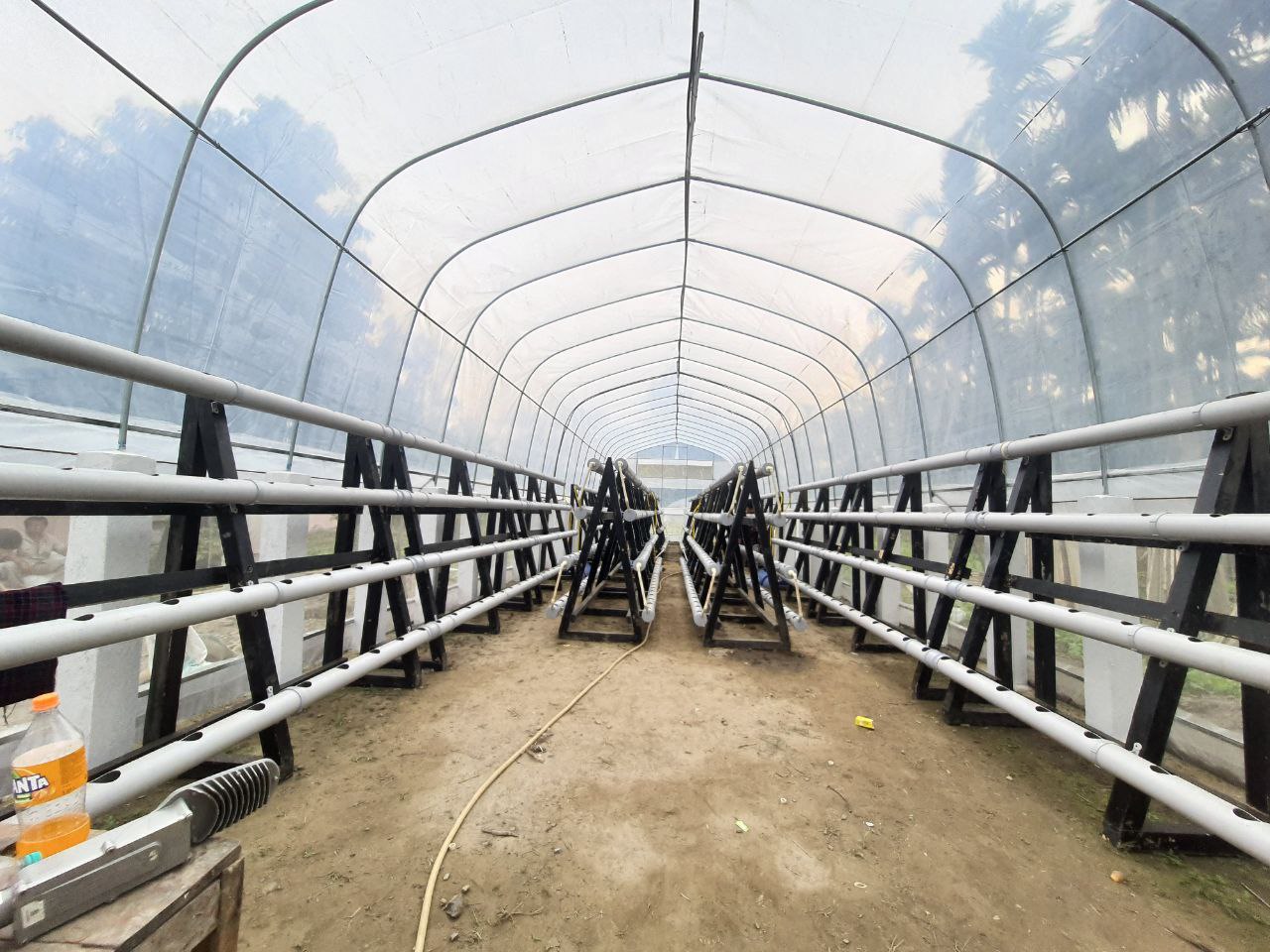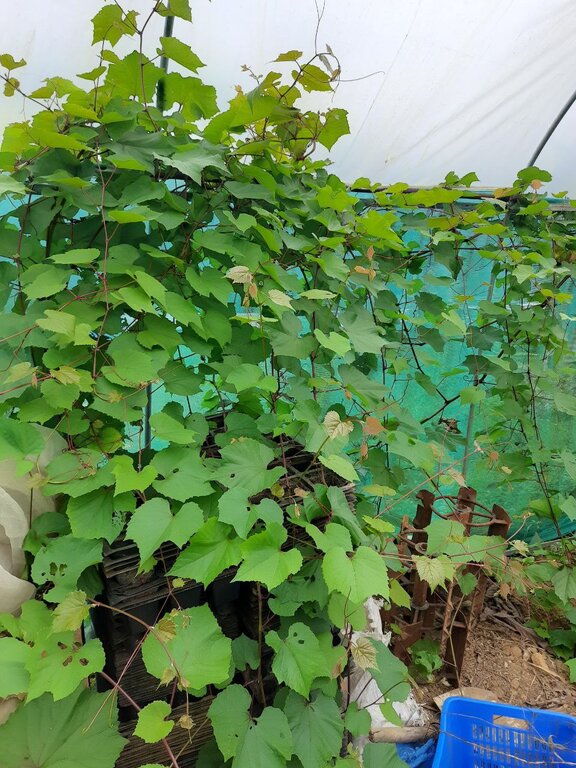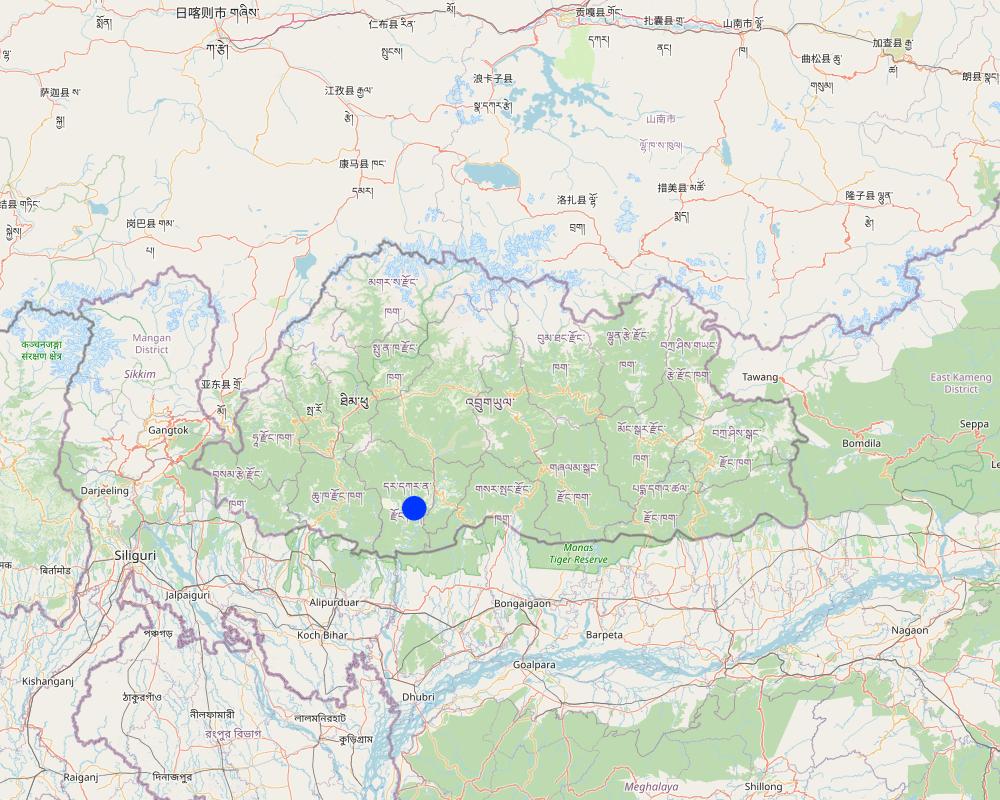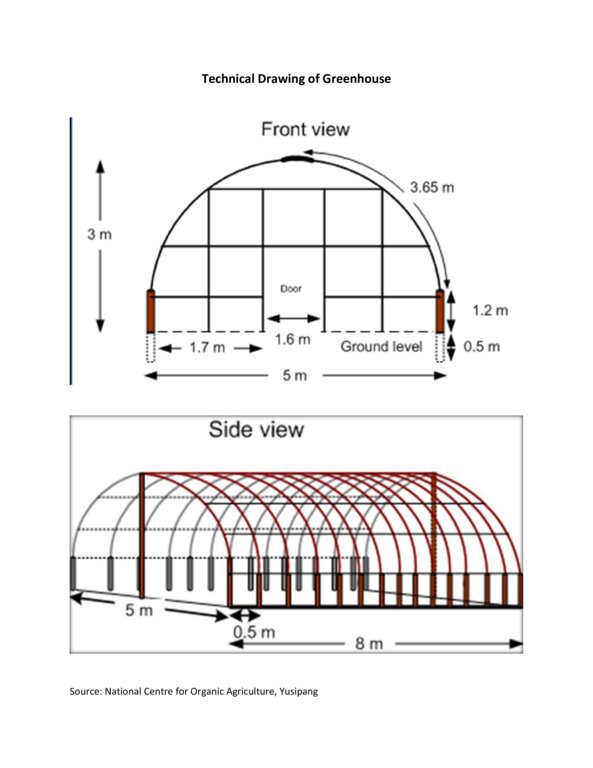Protected Agriculture for High Value Crops [بوتان]
- تاريخ الإنشاء:
- تحديث:
- جامع المعلومات: Nima Dolma Tamang
- المحرر: Haka Drukpa
- المراجعون: William Critchley, Rima Mekdaschi Studer
technologies_6846 - بوتان
عرض الأقسام
توسيع الكل طي الكل1. معلومات عامة
1.2 تفاصيل الاتصال بالأشخاص الرئيسيين لمصدر المعلومات والمؤسسات المشاركة في تقييم وتوثيق التقنية
الشخص (الأشخاص) الرئيسي لمصدر المعلومات
مستخدم الأرض:
Narayan Abi
Abimanyum Farm
بوتان
اسم المشروع الذي سهّل توثيق/تقييم التقنية (إذا كان ذلك على صلة)
Strengthening national-level institutional and professional capacities of country Parties towards enhanced UNCCD monitoring and reporting – GEF 7 EA Umbrella II (GEF 7 UNCCD Enabling Activities_Umbrella II)اسم المؤسسة (المؤسسات) التي سهلت توثيق/تقييم التقنية (إذا كان ذلك على صلة)
National Soil Services Centre, Department of Agriculture, Ministry of Agriculture & Livestock (NSSC) - بوتان1.3 الشروط المتعلقة باستخدام البيانات الموثقة من خلال WOCAT
يوافق جامع المعلومات والشخص (لاشخاص) الرئيسي لمصدر المعلومات على الشروط المتعلقة باستخدام البيانات الموثقة من خلال WOCAT:
نعم
1.4 إعلان بشأن استدامة التقنية الموصوفة
هل التقنية الموصوفة هنا تمثل مشكلة فيما يتعلق بتدهور الأراضي، بحيث لا يمكن إعلانها تقنية مستدامة لإدارة الأراضي؟:
كلا
1.5 الإشارة إلى الاستبيان (الاستبيانات) حول مناهج الإدارة المستدامة للأراضي (موثقة باستخدام WOCAT)
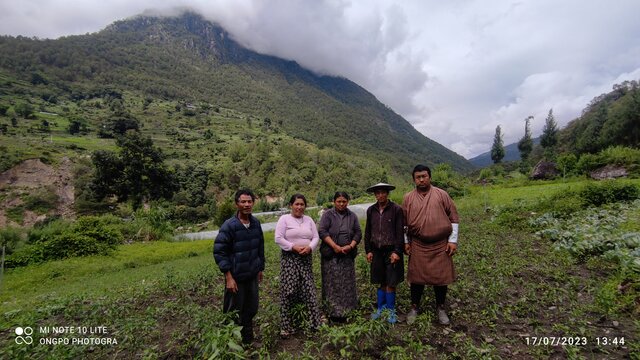
Enhancing Agricultural Production Through Fallow Land Reversion [بوتان]
The approach is to enhance production of local vegetables and fruits through fallow land restoration - under a group established for the purpose.
- جامع المعلومات: Nima Dolma Tamang
2. وصف تقنيةالإدارة المستدامي للأراضي
2.1 وصف مختصر للتقنية
تعريف التقنية:
Protected agriculture (controlled environment agriculture) is the use of technology to modify the growing environment for crops to extend the growing period and increase yields. It can include greenhouses, shade nets or polytunnels. This technology is moderately expensive therefore it is used only for the cultivation of high-value crops and raising seedlings in winter.
2.2 وصف تفصيلي للتقنية
الوصف:
Protected agriculture, also known as controlled environment agriculture, refers to the practice of growing crops within an enclosed structure that provides controlled environmental conditions. There are various structures that can be employed, such as greenhouses, shade nets, polytunnels and glasshouses. This documentation focuses on greenhouses. These are commonly used for cultivating high-value crops that yield a higher economic return per unit area compared to traditional field crops. Technical specification for a 20 m x 5 m greenhouse set consists of a galvanized tubular frame, two doors, UV stabilized 120 GSM cross-laminated clear plastic sheet, channels and a nylon belt for holding the plastic sheet. Construction activities include clearing, levelling the ground and ensuring drainage. Installation of water lines, electrical connections, heating systems and ventilation systems is required.
Greenhouses are typically designed with a framework made of materials like metal, wood, or PVC. The structure must be sturdy enough to support covering materials and withstand environmental loads such as wind and snow. Coverings are transparent or translucent materials that allow sunlight to enter the structure. Common options include glass, polycarbonate panels, or plastic film. The choice of covering material depends on factors such as light transmission, insulation properties, durability, and cost. Greenhouses require adequate ventilation to control temperature, humidity, and air circulation. Vents, louvres, or roll-up side walls can be used to regulate airflow and prevent heat buildup. Exhaust fans or natural ventilation methods help remove excess heat, humidity, and carbon dioxide from the structure. Efficient irrigation systems, such as drip irrigation, and micro-sprinklers, are used to deliver water directly to plants' root zones. Raised beds of 1.2 m width and 30 cm height and planting distance of 60 cm are applied for (for example) watermelon.
Greenhouses allow for the cultivation of plants throughout the year, regardless of the external weather. By maintaining a stable and favourable climate inside, growers can start plants earlier in the spring, extend the growing season into the fall, or even grow plants year-round in certain regions. It shields plants from adverse weather conditions such as frost, heavy rain, wind, or hail, which can damage or destroy crops. Greenhouses provide a physical barrier that safeguards plants from external threats, minimizing the risk of disease, pests, and other environmental stresses.
Greenhouses provide a range of benefits and impacts, including increased food production by extending the growing season and improving food security. They produce higher crop yields by providing optimal growing conditions and conserving water through efficient irrigation systems. Greenhouses also contributes to reduced pesticide use, energy efficiency, local and seasonal produce, employment opportunities, research and innovation, and serves as an attractive space for recreation and education. Overall, greenhouses offer sustainable and efficient solutions for agriculture while enhancing environmental stewardship and community well-being.
Protected agriculture through the use of greenhouses offers land users the ability to control environmental factors, leading to optimal conditions for plant growth and higher crop yields compared to open-field cultivation. It protects from adverse weather conditions, reducing crop losses due to frost, rain, or wind. Additionally, the controlled environment minimizes the risk of pests and diseases, resulting in fewer losses and reduced reliance on pesticides. Overall, greenhouses enhance productivity, profitability, and sustainability for land users. On the other hand, setting up a greenhouse requires a significant initial investment, including the construction or purchase of the structure, equipment, and environmental control systems. Operating a greenhouse involves ongoing costs for utilities, maintenance, and replacement of equipment, which can impact profitability. The cost can be reduced by establishing a low cost greenhouse with locally available materials such as bamboo.
2.3 صور التقنية
2.4 فيديوهات عن التقنية
تعليقات، وصف موجز:
https://www.youtu.be/i8izu3PmQRE
This link provides poly house construction basics video prepared by ARDC Bajo officials and JICA experts of Integrated Horticulture Promotion Project
التاريخ:
01/11/2020
الموقع:
Agriculture Research and Development Sub Centre Tsirang
اسم مصور الفيديو:
JICA Experts and ARDC Bajo Officials
2.5 البلد/المنطقة/المواقع التي تم تنفيذ التقنية فيها والتي يغطيها هذا التقييم
البلد:
بوتان
المنطقة/الولاية/المحافظة:
Dagana Dzongkhag
مزيد من التفاصيل حول الموقع:
Tsendagang Gewog
حدد انتشار التقنية:
- يتم تطبيقها في نقاط محددة/ تتركز على مساحة صغيرة
هل يقع موقع/مواقع التقنية في منطقة محمية بشكل دائم؟:
كلا
التعليقات:
It is leased land and does not fall under a permanently protected area.
Map
×2.6 تاريخ التنفيذ
اذكر سنة التنفيذ:
2020
2.7 إدخال التقنية
- Through other farmers
3. تصنيف تقنية الإدارة المستدامي للأراضي
3.1 الغرض الرئيسي ( الأغراض الرئيسية) للتقنية
- تحسين الإنتاج
- الحد من مخاطر الكوارث
- التخفيف من تغير المناخ وآثاره
- خلق أثر اقتصادي مفيد
- To improve livelihood
3.2 نوع (أنواع) استخدام الأراضي الحالية حيث يتم تطبيق التقنية
استخدامات الأراضي مختلطة ضمن نفس وحدة الأرض:
نعم
حدد استخدام الأراضي المختلطة (المحاصيل / الرعي / الأشجار):
- الحراجة الزراعية

الأراضي الزراعية
- زراعة سنوية
- زراعة معمرة (غير خشبية)
- زراعة الأشجار والشجيرات
الزراعة السنوية - حدد المحاصيل:
- الحبوب البقولية والبقول- الفاصوليا
- الخضروات - البطيخ، اليقطين، الكوسى أو القريع
- خضروات - اخرى
- Chilli
الزراعات المعمرة (غير الخشبية) - حدد المحاصيل:
- الموز/موز الهند/الأباكا
- محاصيل الزهور - المعمرة
زراعة الأشجار والشجيرات -حدد المحاصيل:
- أشجار الجوزيات (جوز البرازيل، الفستق، الجوز، اللوز، الخ.)
عدد مواسم الزراعة في السنة:
- 2
هل يتم ممارسة الزراعة البينية؟:
نعم
إذا كانت الإجابة بنعم، حدد المحاصيل التي يتم زراعتها بشكل بيني:
Watermelon and zucchini are intercropped
هل تتم ممارسة تناوب المحاصيل؟:
نعم
إذا كانت الإجابة بنعم، حدد:
Watermelon is followed by chilli or beans cultivation on the same land
3.3 هل تغير استخدام الأراضي نتيجة لتنفيذ التقنية؟
هل تغير استخدام الأراضي نتيجة لتنفيذ التقنية؟:
- نعم (يرجى ملء الأسئلة أدناه فيما يتعلق باستخدام الأراضي قبل تنفيذ التقنية)
استخدامات الأراضي مختلطة ضمن نفس وحدة الأرض:
كلا

الغابات/ الأراضي الحرجية
- الغابات/الأراضي الحرجية (شبه) الطبيعية
- Natural forest
هل الأشجار المذكورة أعلاه ملحاء أم دائمة الخضرة؟:
- دائمة الخضرة
التعليقات:
The land is a cleared settlement from indigenous subtropical forest. Land use changed from subtropical forest to the agroforestry system where few native trees were retained with fruit trees and crops cultivated.
3.4 إمدادات المياه
إمدادات المياه للأرض التي يتم تنفيذ التقنية عليها:
- ري كامل
التعليقات:
Protected agriculture - especially greenhouses - depends on full irrigation with a drip irrigation system.
3.5 مجموعةالإدارة المستدامة للأراضي التي تنتمي إليها هذه التقنية
- أنظمة التناوب (تعاقب المحاصيل، البور، الزراعة المتنقلة)
- تحسين أصناف النباتات/سلالات الحيوانات
- إدارة الري (بما في ذلك إمدادات المياه والصرف الصحي)
3.6 التدابير التقنية في مجال إلادارة المستدامة للأراضي

التدابير الزراعية
- A1: الغطاء النباتي/التربة
- A2: المادة العضوية/خصوبة التربة

التدابير البنيوية
- S1: المصاطب المتدرجة
- S11: غير ذلك

التدابير الإدارية
- M1: التغيير في نوع استخدام الأراضي
التعليقات:
For the introduction of the technology, excavated or cut-and-fill bench terraces were built to install greenhouses.
3.7 الأنواع الرئيسية من تدهور الأراضي التي تناولتها التقنية

تآكل التربة بالمياه
- الوزن(Wt): فقدان التربة السطحية/تآكل السطح

تآكل التربة الناتج عن الرياح
- (Et): فقدان التربة السطحية

التدهور البيولوجي
- (Bc): تناقص الغطاء النباتي
- (Bp): زيادة الآفات/الأمراض، وفقدان الحيوانات المفترسة

تدهور المياه
- (Hs): التغيير في كمية المياه السطحية
3.8 منع أو حد أو عكس تدهور الأراضي
تحديد هدف التقنية فيما يتعلق بتدهور الأراضي:
- منع تدهور الأراضي
4. المواصفات الفنية، وأنشطة التنفيذ، والمدخلات، والتكاليف
4.1 الرسم الفني للتقنية
المواصفات الفنية (المتعلقة بالرسم الفني):
The technical drawing provided is for the low-cost greenhouse (Made up of bamboo). Generally, the length of a commercial greenhouse is 10 or 20 m and the width of 5 m. The greenhouse can be modified based on the crop to be cultivated. Additional facilities such as drip irrigation set, blower, fan, cooling pad and exhaust fan, temperature sensors are added modify the environment.
المؤلف:
National Centre for Organic Agriculture, Yusipang
المواصفات الفنية (المتعلقة بالرسم الفني):
Technical details for setting up 5m by 20m double poly house protected structure
المؤلف:
ARDC Bajo
التاريخ:
01/07/2020
4.2 معلومات عامة بخصوص حساب المدخلات والتكاليف
حدد كيفية احتساب التكاليف والمدخلات:
- حسب مساحة تنفيذ التقنية
الإشارة إلى حجم ووحدة المساحة:
3.75 acres
عملة أخرى/ عملة وطنية (حدد):
Ngultrum (Nu.)
إذا كان ذا صلة، وضح سعر الصرف من الدولار الأمريكي إلى العملة المحلية (على سبيل المثال، 1 دولار أمريكي = 79.9 ريال برازيلي): 1 دولار أمريكي =:
79,0
اذكر متوسط تكلفة أجر العمالة المستأجرة في اليوم الواحد:
500
4.3 أنشطة التأسيس
| النشاط | التوقيت (الموسم) | |
|---|---|---|
| 1. | Clearing of vegetations | Winter |
| 2. | Agriculture land development | Winter |
| 3. | Field preparation | Winter |
| 4. | Installation of greenhouse and other structure | Winter |
| 5. | Sowing and plantation of crops and fruits (especially late winter crops) | Winter |
التعليقات:
The installation of a greenhouse can be done in any season. However, the most preferred time for the installation is in winter when the crops standing in the field are minimal and the land users are not involved in other farming activities such as paddy cultivation.
4.4 التكاليف والمدخلات اللازمة للتأسيس
| تحديد المدخلات | الوحدة | الكمية | التكاليف لكل وحدة | إجمالي التكاليف لكل مدخل | % من التكاليف التي يتحملها مستخدمو الأراضي | |
|---|---|---|---|---|---|---|
| العمالة | Farm establishment | Number | 30,0 | 500,0 | 15000,0 | 100,0 |
| العمالة | Installation of structure and plantation | Number | 15,0 | 500,0 | 7500,0 | 100,0 |
| معدات | Excavator (farm establishment) | Number of days | 12,0 | 24000,0 | 288000,0 | 100,0 |
| معدات | Power tiller | Per hour | 16,0 | 250,0 | 4000,0 | 50,0 |
| المواد النباتية | Dragon fruit | Per sapling | 300,0 | 50,0 | 15000,0 | |
| المواد النباتية | Watermelon seed | Per packet | 1,0 | 2700,0 | 2700,0 | |
| مواد البناء | Greenhouse | Number | 6,0 | 80000,0 | 480000,0 | 20,0 |
| مواد البناء | Dragon fruit staking | Number | 39,0 | 700,0 | 27300,0 | 100,0 |
| إجمالي تكاليف إنشاء التقنية | 839500,0 | |||||
| إجمالي تكاليف إنشاء التقنية بالدولار الأمريكي | 10626,58 | |||||
إذا تحمل مستخدم الأرض أقل من 100% من التكاليف، حدد من قام بتغطية التكاليف المتبقية:
Royal Government of Bhutan (RGoB)
التعليقات:
For a greenhouse it costs Nu. 80000. Therefore, the total cost of six green houses that are available at the farm is Nu. 480000 (USD 5790). For the greenhouse, 80% is borne by the RGoB. However, for the overall establishment major costs were borne by the land user and a minimal cost was part of the subsidy/fund support from RGoB as shown in the table above. The land user has 4.9 acre of which 3.75 acre is cultivated and 0.11 acre is under protected agriculture.
4.5 الصيانة/الأنشطة المتكررة
التعليقات:
The land user haven't carry out any maintenance due to the recent establishment of the farm. However, there is likely to have a maintenance cost of Nu. 5000 (USD 289) for the greenhouses and overall recurrent cost of Nu. 41975 (USD 506) per annum.
4.6 التكاليف والمدخلات اللازمة للصيانة/للأنشطة المتكررة (سنويًا)
التعليقات:
No maintenance has been carried out
4.7 أهم العوامل المؤثرة على التكاليف
قدم وصفا لأهم العوامل التي تؤثر على التكاليف:
Infrastructure and machinery.
5. البيئة الطبيعية والبشرية
5.1 المناخ
هطول الأمطار السنوي
- < 250 مم
- 251- 500 ملم
- 501 - 750ملم
- 1,000-751 ملم
- 1,500-1,100 ملم
- 2,000-1,500 ملم
- 3,000-2,001 ملم
- 4,000-3,100 ملم
- > 4000 ملم
المنطقة المناخية الزراعية
- شبه رطبة
The area falls under a humid subtropical and warm subtropical zone among the six agro-ecological zones of Bhutan.
5.2 طوبوغرافيا
متوسط الانحدارات:
- مسطح (0-2%)
- بسيط (3-5%)
- معتدل (6-10%)
- متدحرج (11-15%)
- تلال (16-30%)
- شديدة الانحدار(31-60%)
- فائقة الانحدار (>60%)
التضاريس:
- هضاب/سهول
- أثلام مرتفعة
- المنحدرات الجبلية
- منحدرات التلال
- منحدرات في السفوح
- قاع الوادي
المنطقة الارتفاعية:
- 100-0 متر فوق سطح البحر
- 500-101 متر فوق سطح البحر
- 1,000-501 متر فوق سطح البحر
- 1,500-1,001 متر فوق سطح البحر
- 2,000-1,501 متر فوق سطح البحر
- 2,500-2,100 متر فوق سطح البحر
- 3,000-2,501 متر فوق سطح البحر
- 4,000-3,001 متر فوق سطح البحر
- > 4000 متر فوق سطح البحر
وضح ما إذا كانت التقنية مطبقة على وجه التحديد في:
- غير ذات صلة
5.3 التربة
متوسط عمق التربة:
- ضحل جدًا (0-20 سم)
- ضحلة (21-50 سم)
- متوسطة العمق (51-80 سم)
- عميقة (81-120 سم)
- عميقة جدًا (> 120 سم)
قوام التربة (التربة السطحية):
- خشن / خفيف (رملي)
قوام التربة (> 20 سم تحت السطح):
- خشن / خفيف (رملي)
المواد العضوية في التربة السطحية:
- عالية (>3%)
إذا كان متاحًا، قم بإرفاق وصف كامل للتربة أو تحديد المعلومات المتوفرة، على سبيل المثال نوع التربة، الرقم الهيدروجيني/ درجة حموضة التربة، قدرة التبادل الكاتيوني، النيتروجين، الملوحة وما إلى ذلك.
Moisture content 3.31%, organic matter 5.03%, organic carbon 2.92%, pH 5.67, electrical conductivity 337.67 µs/cm, nitrogen 0.15%, phosphorus 0.09 ppm, potassium 123.07 mg/100ml, texture sand clay loam.
The soil analysis was conducted at the Science Laboratory of College of Natural Resources, Royal University of Bhutan, Lobesa, Punakha.
The soil data shared under the section 5.2 is for the growing media used inside the greenhouse. Land user adds organic manure to the existing topsoil which is used as a growing media.
5.4 توافر المياه ونوعيتها
توافر المياه السطحية:
متوسط
نوعية المياه (غير المعالجة):
مياه الشرب سيئة (تتطلب معالجة)
تشير جودة المياه إلى:
المياه السطحية
هل تعتبر ملوحة الماء مشكلة؟:
كلا
هل تحدث فيضانات في المنطقة؟:
كلا
تعليقات ومواصفات أخرى بشأن نوعية المياه وكميتها:
There is a water shortage during the winter season.
5.5 التنوع البيولوجي
تنوع الأنواع:
- متوسط
تنوع الموائل:
- متوسط
التعليقات والمواصفات الإضافية بشأن التنوع البيولوجي:
The species and habitat diversity in the questions above are referred to the farm and not inside the greenhouse.
5.6 خصائص مستخدمي الأراضي الذين يطبقون التقنية
مستقر أو مرتحل:
- غير المترحل
التوجه السوقي لنظام الإنتاج:
- تجاري/سوق
الدخل من خارج المزرعة:
- أقل من % 10من كامل الدخل
المستوى النسبي للثروة:
- متوسط
أفراداً أو مجموعات:
- فرد/أسرة معيشية
مستوى المكننة:
- ميكانيكية/ مزودة بمحرك
الجنس:
- رجال
عمر مستخدمي الأرضي:
- متوسط العمر
5.7 متوسط مساحة الأرض التي يستخدمها مستخدمو الأراضي الذين يطبقون التقنية
- < 0.5 هكتارا
- 0.5 - 1 هكتار
- 1 -2 هكتار
- 2 - 5 هكتار
- 5 - 15 هكتار
- 15 - 50 هكتار
- 50 - 100هكتار
- 500-100 هكتار
- 1,000-500 هكتار
- 10,000-1,000 هكتار
- > 10,000 هكتار
هل يعتبر هذا نطاقًا صغيرًا أو متوسطًا أو واسعا (في إشارة إلى السياق المحلي)؟:
- على نطاق واسع
التعليقات:
The land user has 4.9 acres of which 3.75 acres are cultivated. The average land holding in Bhutan is 3.4 acres, therefore the land users owning/farming more than 3.4 acres are categorized as large-scale.
5.8 ملكية الأراضي، وحقوق استخدام الأراضي، وحقوق استخدام المياه
ملكية الارض:
- فردية، لا يوجد سند ملكية
حقوق استخدام الأراضي:
- مؤجر
حقوق استخدام المياه:
- مجتمعي (منظم)
هل تعتمد حقوق استخدام الأراضي على نظام قانوني تقليدي؟:
نعم
حدد:
Land leasing is a traditional legal system where the land user has a contract with the owner for 20 years. After the completion of the contract term, the land and the infrastructures are to be handed to the land owner.
5.9 الوصول إلى الخدمات والبنية التحتية
الصحة:
- ضعيف
- معتدل
- جيد
التعليم:
- ضعيف
- معتدل
- جيد
المساعدة التقنية:
- ضعيف
- معتدل
- جيد
العمل (على سبيل المثال خارج المزرعة):
- ضعيف
- معتدل
- جيد
الأسواق:
- ضعيف
- معتدل
- جيد
الطاقة:
- ضعيف
- معتدل
- جيد
الطرق والنقل:
- ضعيف
- معتدل
- جيد
مياه الشرب وخدمات الصرف الصحي:
- ضعيف
- معتدل
- جيد
الخدمات المالية:
- ضعيف
- معتدل
- جيد
6. الآثار والتصريحات الختامية
6.1 الآثار التي أظهرتها التقنية في الموقع
الآثار الاجتماعية والاقتصادية
الإنتاج
إنتاج المحاصيل
التعليقات/ حدد:
Compared to open fields, protected agriculture has shown an increase in production. This could be due to the extended growing period, reduced disease incidence and ease of performing cultural activities.
جودة المحاصيل
التعليقات/ حدد:
The crop quality is improved in the protected agriculture as the optimum environmental conditions are provided.
خطر فشل الإنتاج
التعليقات/ حدد:
The risk of production failure is reduced as the crop is not exposed to abiotic stress.
إدارة الأراضي
الكمية قبل الإدارة المستدامة للأراضي:
10%
الكمية بعد الإدارة المستدامة للأراضي:
20%
التعليقات/ حدد:
Land management in the protected cultivation is easier compared to open field.
الدخل والتكاليف
النفقات على المدخلات الزراعية
الكمية قبل الإدارة المستدامة للأراضي:
0%
الكمية بعد الإدارة المستدامة للأراضي:
10%
التعليقات/ حدد:
Initial investment for the establishment of the protected structure is high. However, the expenses on agricultural inputs were reduced after establishment. Further, the initial negative expenses are compensated by the return from selling the farm produce.
دخل المزرعة
الكمية قبل الإدارة المستدامة للأراضي:
20%
الكمية بعد الإدارة المستدامة للأراضي:
70%
التعليقات/ حدد:
There is a significant increase in the farm income after the establishment of the protected structure as the quantity and the quality of the high-value crops increased fetching higher prices. This has led to an increase in farm income.
عبء العمل
التعليقات/ حدد:
The workload has reduced after the establishment of the greenhouse. For example, the greenhouse is equipped with a drip irrigation system in which the land users can regulate the irrigation frequency and need not water the plants manually.
الآثار الاجتماعية والثقافية
الأمن الغذائي / الاكتفاء الذاتي
الكمية قبل الإدارة المستدامة للأراضي:
20%
الكمية بعد الإدارة المستدامة للأراضي:
80%
التعليقات/ حدد:
The increase in agricultural production has made the land user self-sufficient in certain fruits and vegetables. The technology has also contributed to the food security of the farm household as the income generated from the farm can be used to purchase nutritious foods that are not available on the farm.
6.2 الآثار التي أظهرتها التقنية خارج الموقع
توافر المياه
التعليقات/ حدد:
Unlike flooding irrigation in open fields which requires a large amount of water, a protected structure optimizes water usage. It is achieved by drip irrigation and manual irrigation leading to minimum water wastage. This increases water availability on other parts of the farm or for the community.
6.3 تعرض التقنية وحساسيتها لتغير المناخ التدريجي والظواهر المتطرفة/الكوارث المرتبطة بالمناخ (كما يراها مستخدمو الأراضي)
تغير مناخ تدريجي
تغير مناخ تدريجي
| الموسم | زيادة أو نقصان | كيف تتعامل التقنية مع ذلك؟ | |
|---|---|---|---|
| درجة الحرارة السنوية | زيادة | جيدة جدا | |
| هطول الأمطار السنوي | زيادة | جيدة جدا | |
| هطول الأمطار الموسمية | الصيف | زيادة | جيدة جدا |
الظواهر المتطرفة / الكوارث المرتبطة بالمناخ
الكوارث البيولوجية
| كيف تتعامل التقنية مع ذلك؟ | |
|---|---|
| أمراض وبائية | جيدة جدا |
| الإصابة بالحشرات/الديدان | جيدا |
6.4 تحليل التكلفة والعائد
كيف يمكن مقارنة العوائد نسبة لتكاليف الإنشاء (من وجهة نظر مستخدمي الأراضي)؟
عوائد قصيرة الأجل:
سلبي للغاية
عوائد طويلة الأجل:
إيجابي
كيف تتم مقارنة العوائدمع كلفة الصيانة/التكاليف المتكررة (من وجهة نظر مستخدمي الأراضي)؟
عوائد قصيرة الأجل:
محايد/متوازن
عوائد طويلة الأجل:
ايجابي جدا
6.5 اعتماد التقنية
- 11-50%
من بين جميع الذين تبنوا التقنية، كم عدد الذين فعلوا ذلك بشكل تلقائي، أي دون تلقي أي حوافز مادية/مدفوعات؟:
- 10-0%
6.6 التكيف
هل تم تعديل التقنية مؤخرًا لتتكيف مع الظروف المتغيرة؟:
كلا
6.7 نقاط القوة / المزايا / الفرص التي توفرها التقنية
| نقاط القوة/ المزايا/ الفرص من وجهة نظر مستخدمي الأراضي |
|---|
| Improved market access. Protected structures enable off-season cultivation of certain high-value crops such as chilli and beans leading to higher market access and increased income. |
| Reduced pest and disease incidence. This could be due to optimum growing conditions provided to the plant and ease of pest and disease management. For example, the land user can remove a part of the plant that is infested or remove the crop that is infested in the particular greenhouse and still obtain the yield from other greenhouses. This is not possible in the open field condition. |
| Improved quality of the crops. The environmental conditions inside the greenhouse can be maintained at the optimum level required by plants leading to better quality produce. |
| نقاط القوة/ المزايا/ الفرص من وجهة نظر جامع المعلومات أو غيره من الاشخاص الرئيسيين لمصدر المعلومات |
|---|
| Reduced workload. After the establishment of the protected structure, there is less workforce required for the cultivation. |
| Increased production. The land users can extend the growing period in the enclosed structure which leads to increased cropping season per year maximizing agricultural production. |
6.8 نقاط ضعف / مساوىء / مخاطر التقنية وسبل التغلب عليها
| نقاط الضعف/ المساوىء/ المخاطر من وجهة نظر مستخدم الأراضي | كيف يمكن التغلب عليها؟ |
|---|---|
| The establishment of the technology has high initial investment. | Getting loans from financial institutions and sourcing fund from the government. |
| The farm is challenged with labour shortage. | Increasing the daily wage of labour and providing necessary facilities such as clean drinking water, washing and toilet facilities and providing incentives to retain them. |
| Difficult to manage the farm. | Improving record keeping, developing farm calendar and scheduling activities. |
7. المراجع والروابط
7.1 طرق جمع/مصادر المعلومات
- زيارات ميدانية، مسوحات ميدانية
One
- مقابلات مع مستخدمي الأراضي
One
متى تم تجميع البيانات (ميدانيا)؟:
12/07/2023
7.2 المراجع للمنشورات المتاحة
العنوان، المؤلف، السنة، النظام القياسي الدولي لترقيم الكتب ISBN:
ARDC Wengkhar. (2017). Activity completion report for CARELP support to ARDC-Wengkhar.
متاح من أين؟كم التكلفة؟:
https://www.google.com/url?sa=t&source=web&rct=j&opi=89978449&url=https://www.carlep.gov.bt/wp-content/uploads/2016/11/Activity-Completion-Report-2016_17_CARLEP-Support-to-ARDC-wengkhar_FINAL.pdf&ved=2ahUKEwi3wZSPj_CAAxUB3TgGHTh_A0cQFnoECBEQAQ&usg=AOvVaw3lsXjKzuaScR91V1MntyJZ
7.3 روابط للمعلومات ذات الصلة على الإنترنت
العنوان/الوصف:
Polyhouse Construction Basics in Bhutan (Dzongkha language)
عنوان الرابط URL:
https://www.youtube.com/watch?app=desktop&v=i8izu3PmQRE
الروابط والوحدات المواضيعية
توسيع الكل طي الكلالروابط

Enhancing Agricultural Production Through Fallow Land Reversion [بوتان]
The approach is to enhance production of local vegetables and fruits through fallow land restoration - under a group established for the purpose.
- جامع المعلومات: Nima Dolma Tamang
الوحدات المواضيعية
لا يوجد وحدات مواضيعية


